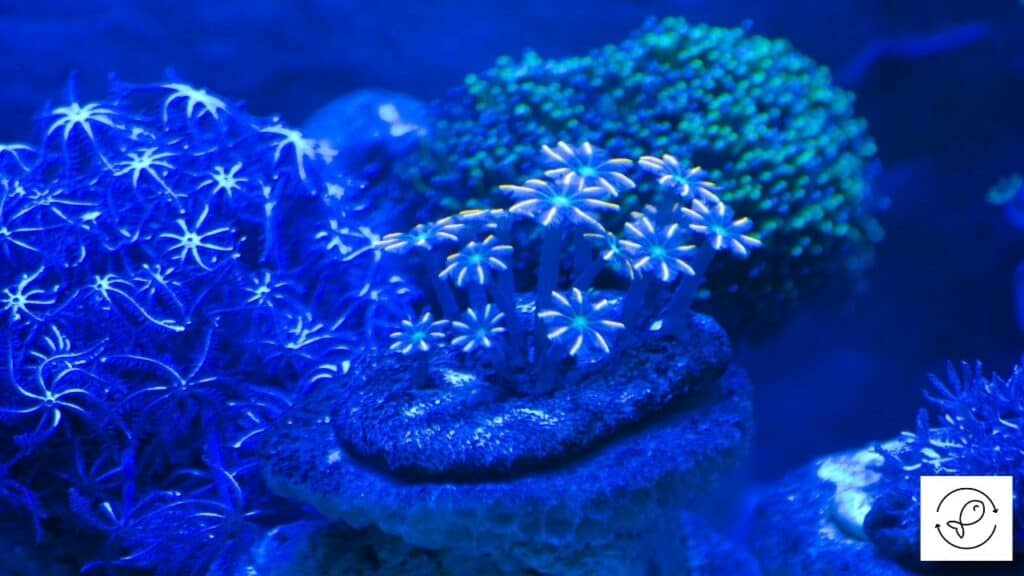LED aquarium lights cause algae if you continuously use them for too many hours at a stretch. However, proper usage of LED lights doesn’t cause algae growth as they emit little heat. Apart from being durable and energy-efficient, they come with many color options and have adjustable light intensity.
Let’s understand this in more detail.
What Causes Algae Growth In Aquariums?
Algae is beneficial to the aquatic ecosystem.
However, their overgrowth deteriorates the health and aesthetics of an aquarium.
Below are the main reasons that cause algae growth in an aquarium:
- Poor Water Quality: It’s the most critical factor. Algae grow when there’s excess ammonia in the water. In addition, these microbes produce toxins that cause algal bloom, which depletes oxygen from the water.
- Nutrient Pollution: Feeding large amounts of food pellets and other nitrogen-rich food to your fish will cause nutrient pollution in the tank. Additionally, excess nitrogen and phosphorous act like fertilizers resulting in an algal bloom in the aquarium.
- Overfeeding: When you feed too much food to your fish, the excess nutrients from these feeds get converted into nitrites and nitrates by the microorganisms. If left untreated, these toxic compounds are fatal to aquatic pets.
- Excess Waste: Overstocking is the primary reason for excessive waste in an aquarium. If you put too many fish in an aquarium, they will produce excess waste. Besides polluting the water, it increases ammonia which fuels algal growth.
- Too Much Lighting: Direct or ambient light from an aquarium fixture should provide adequate illumination for the fish and aquatic plants in the tank. However, excess light causes a rapid rise in the water temperature resulting in an algal bloom.
- Poor Maintenance: If an aquarium has a lot of dirt and debris inside its filtering system, it will increase the nutrients and pollutants in the water. It will not just cause algal bloom but will also harm the fish.
- Improper Filtration System: Filters installed to remove the waste from an aquarium should be compatible with the tank. Using too small or weak filters won’t remove toxins and wastes from the water. As a result, the polluted water will promote algal growth and become harmful to aquatic life.
The reasons mentioned above stimulate algal growth, deplete hygiene, reduce aesthetics, and impact the tank’s ecosystem.
Do Blue LED Lights Cause Algae?
Yes, blue LED lights do cause algae if used excessively. Blue light mimics the moonlight and highlights the transition between dawn and dusk. It’s vital for plant growth, including algae. Excess blue LED lights causes an algal bloom in the aquarium.
The light spectrum comprises seven colors, and blue light is one of the spectrum colors.
Blue light looks beautiful and adds under-the-sea appeal to an aquarium.
Blue light is a high-energy light that helps plants grow by providing lots of energy for photosynthesis.
Moreover, it helps plants produce chlorophyll that helps in photosynthesis.
In the absence of chlorophyll, the plant will starve and eventually perish.
However, you shouldn’t leave the tank lights on for more than 12 hours at a stretch.
Continuous exposure to lights stresses the tank inhabitants and affect their immune systems.
Does Red Light Cause Algae In Reef Tanks?
A reef tank is a marine aquarium with a prominent display of live coral, marine invertebrate species, and fish that help maintain the tropical coral reef ecosystem.
Yes, red light causes algae in reef tanks. However, red light is not the only cause of algal bloom. In a reef tank, corals regulate photosynthesis by using red light. Too much red light negatively affects coral reefs’ ability to regulate their photosynthesis process.
Red light is a low-intensity light source ideal for growing plants and algae.
The red light stimulates plant growth by increasing the rate of cell division.
However, like all other types of lighting, you must keep an eye out for any signs of algae blooms.
If you notice any discoloration, you have to take action right away.
Does Algae Grow In Green Light?
Algae don’t grow in green light because it is poorly absorbed by chlorophyll A, B, and carotenoids that play a vital role in photosynthesis. Therefore, green light is the least effective for plants. However, overuse of green LED lights triggers algae overgrowth.
Some coral species may use green lights for color production. If so, then using one would help them produce brighter hues.
Green light stimulates many proteins (such as DsRed fluorescent protein) to create an array of potential colors.
We also need green lights in our tanks to simulate natural conditions.
In the absence of the green light, the aquarium would appear violet.
Now that you know excessive use of green light causes algal bloom, let’s understand what color light stops algae growth.
What Color Light Stops Algae Growth?
Algae are plant-like protists. Like plants, algae contain chlorophyll that absorbs light and makes food by photosynthesis.
Given below are the colored lights that stop algae growth.
1. Yellow, Orange, And Violet
Plants require little yellow, orange, and violet lights as they have the lowest effect on plant growth.
However, these colors from the lights reflect from the plants, fish, and decor.
So they are essential in creating a beautiful and vibrant aquarium.
2. Soft White
Soft white light creates more viewing light.
Unfortunately, it’s not very practical for growing plants as it has very little red light and just enough deep blue light.
However, you can use it in your aquarium to stop algae growth.
Finally, algae are an essential part of the natural ecosystem.
They are mostly harmless if you maintain good water quality, avoid nutrient pollution, and install adequate lighting in the aquarium.

